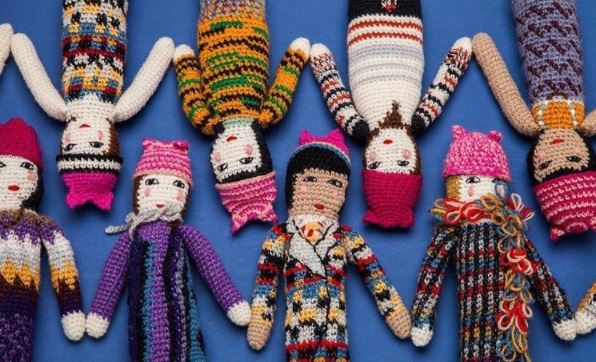For her Fall 2018 collection, Miuccia Prada sent a riot of eye-popping neon and candy-coloured pastels across the Milanese night skyline. “My dream is for women to be able to go out in the street late at night and not be afraid,” said the designer, whose latest vision fits her feminist outlook. Famous for creating clothes with a dual purpose – clothes that are both powerful and feminine, serious and playful – Prada produced a collection that offers protection and charm, one that focuses on making women visible. Industrial chic meets after-party, these are clothes for an all-night bender.
The setting couldn’t have been more perfect for this glow-in-the-dark collection. The show was held in the new extension to the Prada Foundation in Milan, a former distillery turned art space. Simply called ‘Torre’, this striking white tower designed by OMA offers fabulous views of Milan whilst providing a welcome landmark for the area. Yet to be opened to the public so still in a sense a building site, the fourth floor had a nightclub feel, merging with the city’s nightscape by way of neon signs, a black mirrored floor and electronic music, complete with a drone filming proceedings.
Despite the feel-good colours on display, the show didn’t garner the best reviews. It could well be that the 15-minute wait for the lift that never came (surely a metaphor for something) made the fashion pack somewhat less receptive to the wares on display. Whilst not the most overtly sexy of shows, the juxtaposition of colours and fabrics has a charm of its own; these are clothes that grab your attention. There’s a certain modesty to them too; although the longer you look, the more they reveal.
I thought about Muriel Spark, in particular the Italophile/Mussolini enthusiast Jean Brodie, when visiting the Post Zang Tumb Tuuum. Art Life Politics: Italia 1918–1943 exhibition, currently running at the Prada Foundation. It’s an extensive exhibition that charts the role of art and culture between the wars in a country dominated by fascism (with interesting timing given the recent shift in Italian politics towards populism and the far-right). The exhibition puts the art into context by recreating original exhibitions and offering a detailed timeline of events, as well as documenting the extent to which artists collaborated with the regime. It is particularly strong on the Futurists and their art of explosive colour.
It was only when I saw the images from the Prada Fall show however that the Muriel Spark centenary editions immediately sprung to mind (all 22 of her novels are being reprinted by Polygon this year to mark the centenary of Spark’s birth). The eye-catching book jackets designed by Teresa Monachino come in a variety of mouth-watering candy pastels and bright neons. Much like the latest Prada collection, it is hard to avert your gaze.
And so, beset by the flu, I set about matching book covers with outfits (a surprisingly soothing activity, much like doing a jigsaw puzzle) with uncanny results.
Whilst the matchmaking worked wonderfully with the Polygon editions, the New Directions edition of The Driver’s Seat (below left) also has its counterpart.
The model (above right) looks like she could be the main character in The Driver’s Seat – Lise: a woman on a mission who could well have a knife in her handbag. The 1974 film adaptation starring Elizabeth Taylor is overdue for a remake and Miuccia Prada would be the perfect collaborator.
Muriel Spark loved clothes and accessories. I don’t know of her relationship with the fashion house, if any, however I like to imagine that Miuccia Prada and Muriel Spark would have got on well: both strong, independent, commercially successful female artists with a clear vision; both productive and experimental, playing with form whilst exploring opposites and extremes; artists whose work offers a much deeper commentary behind the glossy facade.































 Even a simple gesture such as flying both the Jamaican and Scottish flags above the plinth would be a welcome display of solidarity. It is no coincidence that the two flags are so similar in design. There is in fact a new lottery-funded project called
Even a simple gesture such as flying both the Jamaican and Scottish flags above the plinth would be a welcome display of solidarity. It is no coincidence that the two flags are so similar in design. There is in fact a new lottery-funded project called